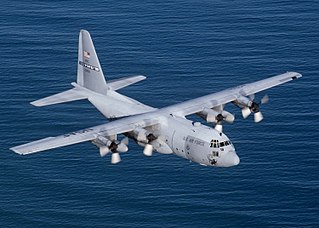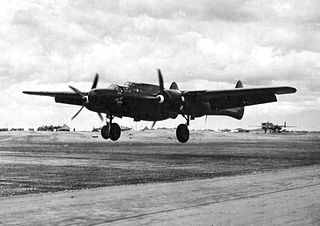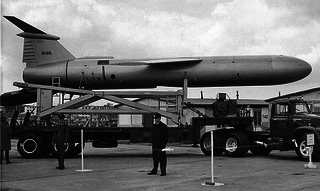
The 43rd Air Mobility Operations Group is an active duty air mobility unit at Pope Army Airfield, Fort Liberty, North Carolina and is part of the Air Mobility Command (AMC) under the USAF Expeditionary Center. The unit is composed of eight squadrons, including one of the only two active Air Force aeromedical evacuation squadrons based in the United States. The group's primary mission focuses on providing enroute operations and enabling global response and airborne support for Fort Liberty's 82nd Airborne Division.

The 312th Aeronautical Systems Group is an inactive United States Air Force unit. It was last active in June 2010 at Wright-Patterson Air Force Base, Ohio, where it was a component of Air Force Materiel Command.

The 345th Bombardment Group is an inactive United States Air Force unit. Its last assignment was with the Tactical Air Command at Langley Air Force Base, Virginia, where it was inactivated on 25 June 1959.

The 417th Bombardment Group is an inactive United States Army Air Forces unit. Its last assignment was with V Bomber Command at Itami Airfield, Japan, where it was inactivated on 5 November 1945.

The 309th Air Division is an inactive United States Air Force organization. Its last assignment was with Continental Air Command, assigned to Twelfth Air Force at Hensley Field, Texas. It was inactivated on 27 June 1949.

The 310th Air Division is an inactive United States Air Force organization. Its last assignment was with Continental Air Command's Twelfth Air Force at Tinker Air Force Base, Oklahoma, where it was inactivated on 27 June 1949.

The 308th Bombardment Wing is an inactive United States Air Force unit. Its last assignment was with Far East Air Forces at Nagoya, Japan, where it was inactivated on 30 June 1948.

The 63d Bombardment Squadron is an inactive United States Air Force unit that was last assigned to the 43rd Bombardment Wing at Little Rock Air Force Base, Arkansas, where it was inactivated on 31 January 1970.

The 64th Bombardment Squadron is an inactive United States Air Force unit that was last assigned to the 43rd Bombardment Wing at Little Rock Air Force Base, Arkansas, where it was inactivated on 31 January 1970.

The 403d Bombardment Squadron is an inactive United States Air Force unit. It was last assigned to the 43rd Bombardment Wing at Carswell Air Force Base, Texas, where it was inactivated on 1 January 1961.

The 405th Tactical Missile Squadron is an inactive United States Air Force unit. It was first organized in January 1941 as the 15th Reconnaissance Squadron. In early 1942, shortly after the attack on Pearl Harbor, the squadron's ground echelon moved to reinforce American forces in Australia, although the air echelon remained in the United States for additional training until August. While completing its training, the unit was redesignated the 405th Bombardment Squadron. The squadron moved forward through New Guinea and the Philippines, earning three Distinguished Unit Citations for its combat actions, operating from Okinawa in the closing month of the war. Following V-J Day, it moved to Japan and became part of the occupation forces until inactivating in April 1949.

The 499th Bombardment Squadron is an inactive United States Air Force unit. It was last assigned to the 345th Bombardment Wing at Langley Air Force Base, Virginia, where it was inactivated on 25 June 1959.

The 500th Bombardment Squadron is an inactive United States Air Force unit. It was last assigned to the 345th Bombardment Wing at Langley Air Force Base, Virginia, where it was inactivated on 25 June 1959.

The 501st Bombardment Squadron is an inactive United States Air Force unit. It was last assigned to the 345th Bombardment Wing at Langley Air Force Base, Virginia, where it was inactivated on 25 June 1959.

The 823rd Tactical Missile Squadron is an inactive United States Air Force unit. Its last assignment was with the 38th Tactical Missile Wing at Sembach Air Base, Germany, where it was inactivated on 25 September 1966, as the A model of the MGM-13 Mace was phased out of operation.

The 672d Technical Training Squadron is an inactive United States Air Force unit. Its last assignment was with the 705th Strategic Missile Wing at RAF Lakenheath, England, where it was inactivated on 1 October 1959.

The 673d Bombardment Squadron is an inactive United States Army Air Forces unit. Its last assignment was with the 417th Bombardment Group at Itami Airfield, Japan, where it was inactivated on 5 November 1945.

The 675th Bombardment Squadron is a former United States Army Air Forces unit. Its last assignment was with the 417th Bombardment Group at Itami Airfield, Japan, where it was inactivated on 5 November 1945.

The 90th Expeditionary Air Refueling Squadron is a provisional United States Air Force unit. Until March 2013, it was assigned to the 385th Air Expeditionary Group at Incirlik Air Base, Turkey. It then departed for an undisclosed location in Southwest Asia.

The 340th Expeditionary Air Refueling Squadron is a provisional United States Air Force unit. It is assigned to the 379th Expeditionary Operations Group at Al Udeid Air Base, Qatar. It has supported combat operations in Afghanistan, Iraq, and Syria from this location.




















